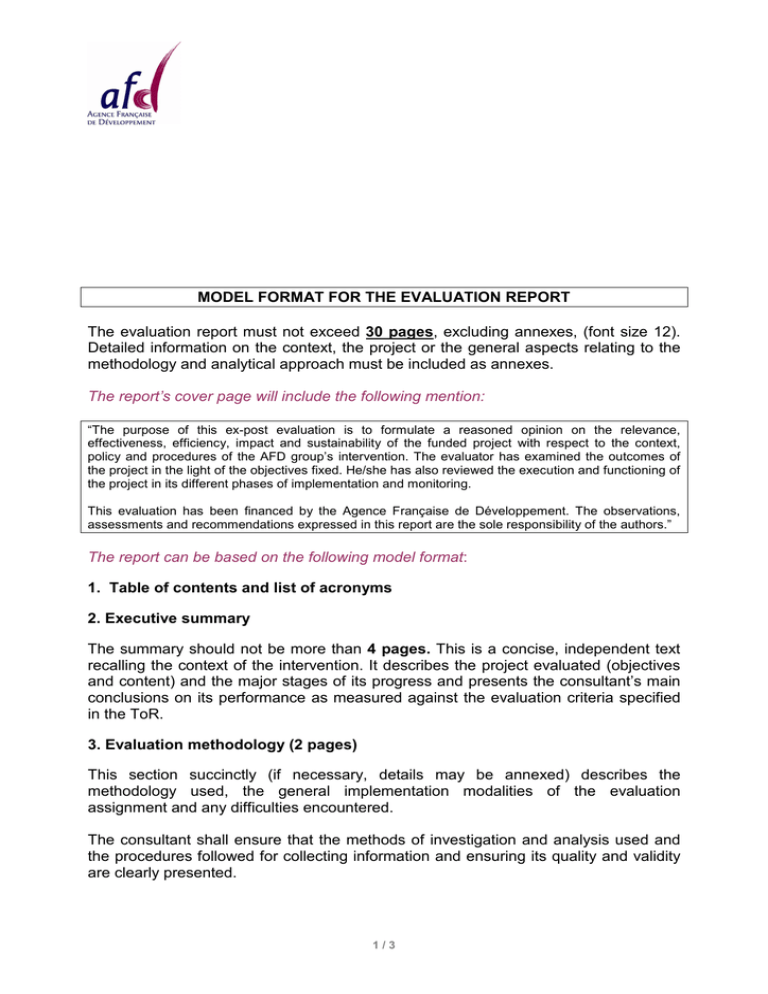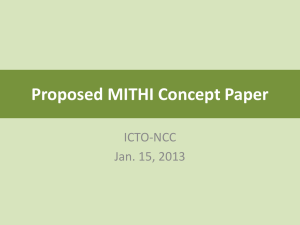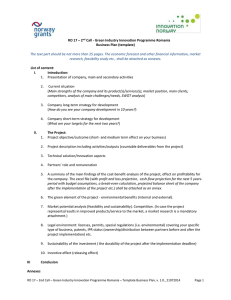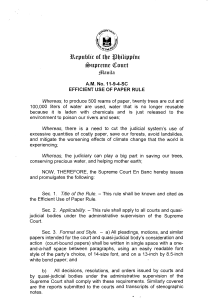MODEL FORMAT FOR THE EVALUATION REPORT The
advertisement

MODEL FORMAT FOR THE EVALUATION REPORT The evaluation report must not exceed 30 pages, excluding annexes, (font size 12). Detailed information on the context, the project or the general aspects relating to the methodology and analytical approach must be included as annexes. The report’s cover page will include the following mention: “The purpose of this ex-post evaluation is to formulate a reasoned opinion on the relevance, effectiveness, efficiency, impact and sustainability of the funded project with respect to the context, policy and procedures of the AFD group’s intervention. The evaluator has examined the outcomes of the project in the light of the objectives fixed. He/she has also reviewed the execution and functioning of the project in its different phases of implementation and monitoring. This evaluation has been financed by the Agence Française de Développement. The observations, assessments and recommendations expressed in this report are the sole responsibility of the authors.” The report can be based on the following model format: 1. Table of contents and list of acronyms 2. Executive summary The summary should not be more than 4 pages. This is a concise, independent text recalling the context of the intervention. It describes the project evaluated (objectives and content) and the major stages of its progress and presents the consultant’s main conclusions on its performance as measured against the evaluation criteria specified in the ToR. 3. Evaluation methodology (2 pages) This section succinctly (if necessary, details may be annexed) describes the methodology used, the general implementation modalities of the evaluation assignment and any difficulties encountered. The consultant shall ensure that the methods of investigation and analysis used and the procedures followed for collecting information and ensuring its quality and validity are clearly presented. 1/3 4. Overall project report (5 pages) This section must include: a general presentation of the context and its developments occurring during project implementation, a description of the project (objectives, contents, intervening parties, procedures), a summary of the project’s progress since its inception (if necessary, include detailed figures and collected data in the annexes), highlighting the main events that affected the project, presenting allocation and volume of mobilised funds, pointing out the main difficulties encountered and mentioning, where appropriate, any realignments carried out. 5. Project performance (12 to 15 pages) It is strongly recommended that the evaluative analysis be structured around the criteria, with 2 to 3 pages for each of the criterion specified in the ToR. The consultancy must clearly explain the step progression between the observations (raw data), the findings (constructed indicators, ratios) and the judgements made. 5.1 Relevance 5.2 Effectiveness 5.3 Efficiency 5.4 Impact of the project 5.5 Sustainability 5.6 AFD’s contribution/additionality 6. Conclusions (4 pages) The evaluation should lead to a reasoned judgement and conclusions on the performance of the AFD-funded project. This section must summarise the consultant’s overall assessment of the project’s performance in the light of the evaluative analysis. The strengths and weaknesses of the project must be clearly described. The consultant will formulate a limited number of conclusions in order to guarantee their high standard of quality. He will clarify or omit any value judgement that is not sufficiently supported by facts. He will also make sure that the evaluation criteria are used in a balanced manner. The conclusions and any lessons learned are listed, categorised and prioritised in a few pages. The methodological limits will be mentioned, as will any differing opinions. 2/3 7. Annexes to the report The annexes can include: • • • • • • • • • terms of reference list of people met assignment schedule field interviews report list of documents consulted list of activities specifically examined and the situation map of interventions eventual details on the chosen evaluation method logical framework of the intervention reconstituted ex-post tables on the funds mobilised, the results or the impacts 3/3


